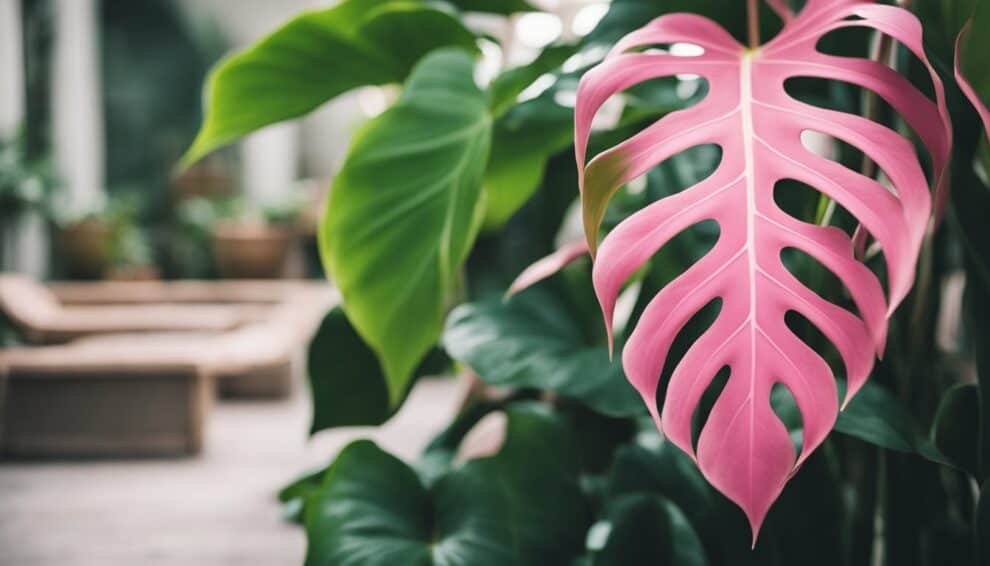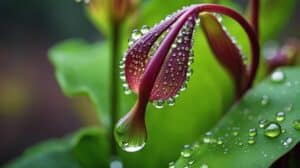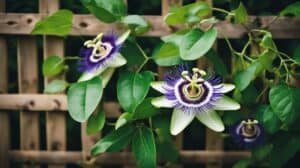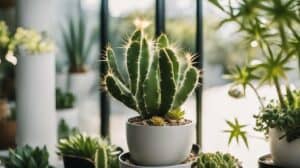The Pink Princess Philodendron has become a popular indoor plant among gardening enthusiasts.
Its unique appearance, with its pink and green variegated leaves, makes it a stunning addition to any indoor garden.
However, growing this enchanting plant requires a bit of knowledge and effort.

To start, it is important to understand the ideal growing conditions for the Pink Princess Philodendron.
These plants thrive in bright, indirect light and require well-draining soil.
Overwatering can be detrimental to their growth, so it is important to allow the soil to dry out slightly between watering.
With the right conditions, the Pink Princess Philodendron can grow to be a truly royal addition to any indoor garden.
Understanding the Pink Princess Philodendron

Botanical Profile
The Pink Princess Philodendron, scientifically known as Philodendron erubescens, is a tropical plant native to South America.
It belongs to the Araceae family and is a popular houseplant due to its unique appearance and low maintenance requirements.
This plant is a climbing vine that can grow up to 3-6 feet tall indoors, and up to 10-15 feet tall in its natural habitat.
Its leaves are heart-shaped and can grow up to 8 inches long and 5 inches wide.
The Pink Princess Philodendron is known for its striking pink variegation, which is caused by a mutation in its chlorophyll production.
Unique Characteristics
The Pink Princess Philodendron is a unique plant with several interesting characteristics. Here are a few notable ones:
-
Variegation: As mentioned earlier, the Pink Princess Philodendron is known for its pink variegation.
The variegation can vary from plant to plant, with some having more pink than others.
-
Low Light Tolerance: This plant can tolerate low light conditions, making it an ideal houseplant for those with limited natural light.
-
Air Purification: Like many other plants, the Pink Princess Philodendron is known for its air-purifying properties.
It can help remove toxins such as formaldehyde and benzene from the air.
-
Toxicity: While the Pink Princess Philodendron is a beautiful plant, it is toxic to humans and pets if ingested.
It contains calcium oxalate crystals, which can cause irritation and swelling in the mouth and throat.
Overall, the Pink Princess Philodendron is a unique and beautiful plant that can add a touch of royalty to any indoor garden.
With proper care and maintenance, this plant can thrive and bring joy to its owner for years to come.
Cultivating a Healthy Plant

Ideal Soil Composition
The Pink Princess Philodendron thrives in well-draining soil that is rich in organic matter.
A good soil mix for this plant should contain peat moss, perlite, and vermiculite in equal parts.
This will help to provide good drainage while retaining enough moisture to keep the plant healthy.
Watering Requirements
Overwatering is one of the most common mistakes made when caring for the Pink Princess Philodendron.
It is important to allow the soil to dry out slightly between waterings.
The frequency of watering will depend on the temperature and humidity of the room, as well as the size of the pot and the amount of light the plant is receiving.
As a general rule, it is better to underwater than overwater this plant.
Light and Temperature Needs
The Pink Princess Philodendron prefers bright, indirect light.
Direct sunlight can scorch the leaves, while too little light can cause the plant to become leggy and weak.
This plant also prefers warm temperatures between 65-80°F (18-27°C).
It is important to avoid placing the plant near drafts or cold windows, as this can damage the leaves and cause the plant to become stressed.
In summary, cultivating a healthy Pink Princess Philodendron requires a well-draining soil mix, careful watering, and appropriate light and temperature conditions.
By providing these basic needs, this enchanting plant will thrive and add a touch of royalty to any indoor garden.
Propagation Techniques
Stem Cuttings
One of the easiest and most popular ways to propagate Pink Princess Philodendron is through stem cuttings.
To do this, simply cut a healthy stem from the mother plant, making sure it has at least one node. Remove the bottom leaves, leaving only a few at the top.
Dip the cut end in rooting hormone and plant it in a well-draining potting mix. Water it thoroughly and keep it in a warm, humid spot with indirect light.
After a few weeks, roots should start to form and new growth will appear.
Air Layering
Another propagation technique that works well for Pink Princess Philodendron is air layering.
This method involves making a small cut in the stem of the plant and then wrapping it in a moist sphagnum moss.
Cover the moss with plastic wrap and secure it with tape. After a few weeks, roots will start to form in the moss.
Once the roots are well-established, cut the stem below the moss and plant it in a well-draining potting mix.
Water it thoroughly and keep it in a warm, humid spot with indirect light.
Overall, both of these propagation techniques are effective and easy to do.
With a little patience and care, you can grow your own Pink Princess Philodendron and add a touch of royalty to your indoor garden.
Common Challenges and Solutions

Pest Prevention
One of the most common challenges when growing the Pink Princess Philodendron is pest infestation.
These plants are susceptible to spider mites, mealybugs, and scale insects. To prevent these pests, it is important to keep the plant clean and well-maintained.
Regularly wiping down the leaves with a damp cloth can help prevent dust buildup and keep pests at bay.
Additionally, inspecting the plant regularly for signs of infestation and treating it promptly can help prevent the spread of pests to other plants.
Disease Management
Another challenge that indoor gardeners may face when growing the Pink Princess Philodendron is disease.
These plants are prone to root rot and leaf spot diseases. To prevent root rot, it is important to ensure that the soil is well-draining and not too wet.
If leaf spot diseases are detected, it is important to remove and dispose of the affected leaves and treat the plant with a fungicide.
Additionally, ensuring that the plant is not overwatered and has good air circulation can help prevent the spread of disease.
Leaf Discoloration Issues
Leaf discoloration issues are also common when growing the Pink Princess Philodendron.
These plants may develop yellow or brown leaves, which can be caused by a variety of factors such as overwatering, underwatering, too much or too little light, or nutrient deficiencies.
To prevent these issues, it is important to ensure that the plant is receiving the appropriate amount of water and light, and that it is fertilized regularly with a balanced fertilizer.
If leaf discoloration issues persist, it may be necessary to adjust the plant’s environment or seek advice from a horticulturist.
Frequently Asked Questions

What are the ideal conditions for maintaining the vibrant pink variegation in a Pink Princess Philodendron?
To maintain the vibrant pink variegation in a Pink Princess Philodendron, it is essential to provide it with bright, indirect light.
The plant also requires high humidity levels, which can be achieved by misting the leaves regularly or placing a humidifier nearby.
Keep the plant away from drafts and ensure that the temperature stays between 65°F and 80°F.
How often should a Pink Princess Philodendron be watered for optimal growth?
The Pink Princess Philodendron prefers to be kept moist but not waterlogged. Water the plant thoroughly when the top inch of soil feels dry.
Avoid letting the plant sit in standing water, as this can lead to root rot. During the winter months, reduce watering frequency.
What steps are involved in the propagation of a Pink Princess Philodendron?
The Pink Princess Philodendron can be propagated through stem cuttings.
Take a cutting with at least two nodes and place it in water or a well-draining potting mix.
Keep the cutting in a warm, humid environment and wait for roots to develop before transplanting it into a new pot.
How can I effectively prune my Pink Princess Philodendron to encourage healthy growth?
To encourage healthy growth, prune your Pink Princess Philodendron in the spring or summer. Remove any dead or yellowing leaves and cut back any leggy stems.
Pinch off the tips of the remaining stems to promote bushier growth.
Why is the Pink Princess Philodendron considered a premium plant, and what justifies its price?
The Pink Princess Philodendron is considered a premium plant due to its striking pink variegation and relative rarity.
The plant is slow-growing and difficult to propagate, which contributes to its high price point.
Can you recommend the best type of potting mix for nurturing a Pink Princess Philodendron?
The Pink Princess Philodendron prefers a well-draining potting mix that retains moisture without becoming waterlogged.
A mix of peat moss, perlite, and vermiculite is a good choice. Add some orchid bark or charcoal to improve drainage.














